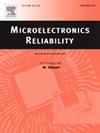Understanding improved pitting corrosion resistance under high temperature application leading to a newly developed palladium coated copper wire
IF 1.6
4区 工程技术
Q3 ENGINEERING, ELECTRICAL & ELECTRONIC
引用次数: 0
Abstract
As the application of palladium coated copper (PCC) wire in automotive semiconductor sector increases, its reliability under high temperature is a topic of frequent discussion ever in the industry. One of the reliability concerns for PCC wire is pitting corrosion at ball bond and wedge bond contact areas. Pitting corrosion is a unique issue for PCC wire that could become prominent at high temperature (≥175 °C) in a sulfur containing environment. To overcome this issue, we developed a new PCC wire that has exceptionally high resistance against pitting corrosion by introducing the corrosion inhibitor inside the Pd coating layer. This paper discusses the reliability performance of the new wire, including the results of high temperature storage life test at elevated temperatures (up to 250 °C) and the investigation of the improving mechanism by high resolution microstructural analysis.
了解提高高温应用下的点蚀性,从而开发出一种新钯包覆铜线
随着镀钯铜线在汽车半导体领域的应用越来越广泛,其高温下的可靠性一直是业界讨论的热点问题。PCC线的可靠性问题之一是球键和楔键接触区域的点蚀。点蚀是PCC电线的一个独特问题,在含硫环境中的高温(≥175°C)可能会变得突出。为了解决这个问题,我们开发了一种新的PCC电线,通过在Pd涂层中引入缓蚀剂,该电线具有极高的抗点蚀能力。本文讨论了新型焊丝的可靠性性能,包括高温(高达250°C)下的高温储存寿命试验结果,以及通过高分辨率显微组织分析对改进机理的研究。
本文章由计算机程序翻译,如有差异,请以英文原文为准。
求助全文
约1分钟内获得全文
求助全文
来源期刊

Microelectronics Reliability
工程技术-工程:电子与电气
CiteScore
3.30
自引率
12.50%
发文量
342
审稿时长
68 days
期刊介绍:
Microelectronics Reliability, is dedicated to disseminating the latest research results and related information on the reliability of microelectronic devices, circuits and systems, from materials, process and manufacturing, to design, testing and operation. The coverage of the journal includes the following topics: measurement, understanding and analysis; evaluation and prediction; modelling and simulation; methodologies and mitigation. Papers which combine reliability with other important areas of microelectronics engineering, such as design, fabrication, integration, testing, and field operation will also be welcome, and practical papers reporting case studies in the field and specific application domains are particularly encouraged.
Most accepted papers will be published as Research Papers, describing significant advances and completed work. Papers reviewing important developing topics of general interest may be accepted for publication as Review Papers. Urgent communications of a more preliminary nature and short reports on completed practical work of current interest may be considered for publication as Research Notes. All contributions are subject to peer review by leading experts in the field.
 求助内容:
求助内容: 应助结果提醒方式:
应助结果提醒方式:


